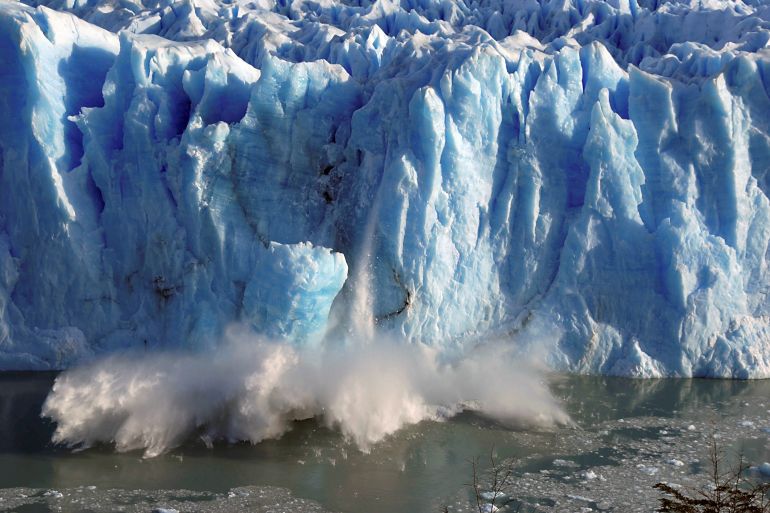Glaciers melting at a faster rate, new study finds
Accelerating pace of melt contributing more than 20 percent to sea level rise, threatens populous coastal cities.

Nearly all of the world’s glaciers are losing mass – and at an accelerated pace, according to a new study that experts said painted an “alarming picture”.
The research published on Wednesday in the science journal Nature provides one of the most wide-ranging overviews yet of ice mass loss from about 220,000 glaciers around the world, a major source of sea-level rise.
Keep reading
list of 4 items‘I blame the government’: Poor Kenyans say no support amid record flooding
Thousands evacuated, flights disrupted as Indonesian volcano erupts again
Three Eswatini chiefdoms overcome rivalry to preserve indigenous forest
Using high-resolution imagery from NASA’s Terra satellite from 2000-2019, a group of international scientists found that glaciers, with the exception of the Greenland and Antarctic ice sheets which were excluded from the study, lost an average of 267 gigatonnes of ice per year.
A gigatonne of ice would fill New York City’s Central Park and stand 341 metres (1,119 feet) high.
The researchers also found that glacier mass loss accelerated. Glaciers lost 227 gigatonnes of ice annually from 2000 to 2004, but that increased to an average of 298 gigatonnes each year after 2015.
The melt was significantly impacting sea levels by about 0.74 millimetres a year, or 21 percent of overall sea-level rise observed during the period.
Glaciers tend to have a faster response to climate change compared with ice sheets in Greenland and Antarctica, and are currently contributing more to sea-level rise than either individual ice sheet, scientists said.
The study could fill important gaps in understanding ice mass loss, leading to more accurate predictions, said co-author of the study Robert McNabb, a remote sensing scientist at Ulster University in the United Kingdom. Previous studies looking at individual glaciers only account for about 10 percent of the planet, he said.
Scientists have long warned that warming temperatures driven by climate change are eating into glaciers and ice sheets around the world, contributing to higher sea levels that threaten the world’s populous coastal cities.
Global thinning rates, different than volume of water lost, doubled in the last 20 years and “that’s enormous,” said Romain Hugonnet, a glaciologist at ETH Zurich and the University of Toulouse in France who led the study.
Shrinking glaciers are a problem for millions of people who rely on seasonal glacial melt for daily water and rapid melting can cause deadly outbursts from glacial lakes in places like India, added Hugonnet.
“Ten years ago, we were saying that the glaciers are the indicator of climate change, but now actually they’ve become a memorial of the climate crisis,” said World Glacier Monitoring Service Director Michael Zemp, who was not part of the study.
Some glaciers in Alaska, Iceland, the Alps, the Pamir Mountains and the Himalayas were among the most impacted by melting, researchers found.
“Those areas are seeing a rapid pace of glacier melt that could be fairly worrying,” McNabb said.
“We get this increase in melt and that actually increases the availability of water that comes in these rivers … but the problem is, after a period of time, that stops increasing and then decreases fairly rapidly,” he added.
Human emission leading cause
While the study did not delve into the cause of the glacial retreat, rising temperatures widely believed by scientists to be the result of human emissions were inevitably leading to more ice loss, McNabb said.
“It’s hard to separate the fact that the temperature is what is causing the melt with the fact that humans are, by and large, causing the increase in temperature,” he said.
Once glacial ice melts, it could take decades or centuries to regrow because it must pile up year after year, scientists said.
The study reiterates that the world must bring down global temperatures to slow ice loss, said Twila Moon, a glaciologist at the National Snow and Ice Data Center who was not involved in the study.
“I have no expectation, in all honesty, that even substantial action to reduce our emissions and control the Earth’s temperature rise is going to grow our glaciers,” Moon said. “We’re at a point where we’re trying to keep as much ice as possible and slow that rate of loss,” she added.
While researchers identified instances where melt rates actually slowed between 2000 and 2019, like Greenland’s east coast, they attributed that to a weather anomaly that led to higher precipitation and lower temperatures.
McNabb said the study’s overall picture was one of “fairly rapid” ice mass loss, with no indication it would change soon, but there is still time to put the brakes on melt by reducing emissions.
“When you see something like this where glaciers are losing mass, it’s getting faster, that sounds really bad,” he said. “But there’s something that we can do here, we need to act.”